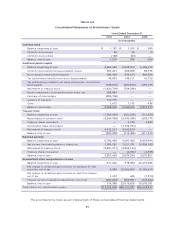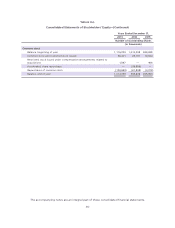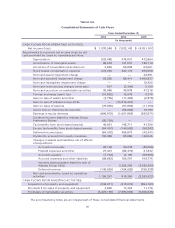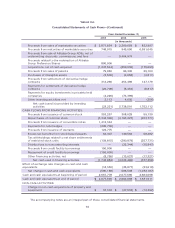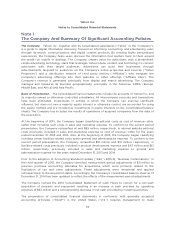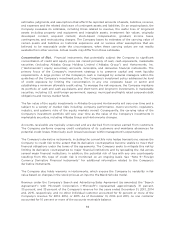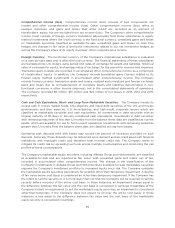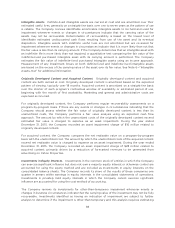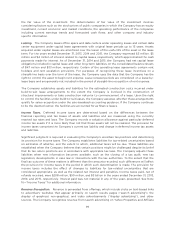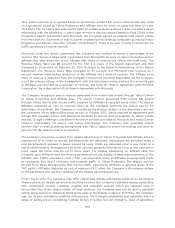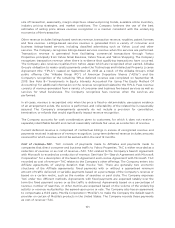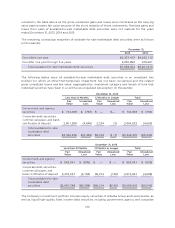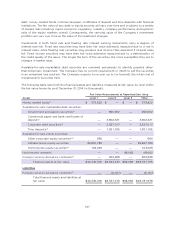Yahoo 2015 Annual Report Download - page 102
Download and view the complete annual report
Please find page 102 of the 2015 Yahoo annual report below. You can navigate through the pages in the report by either clicking on the pages listed below, or by using the keyword search tool below to find specific information within the annual report.Intangible Assets. Definite-lived intangible assets are carried at cost and are amortized over their
estimated useful lives, generally on a straight-line basis over one to seven years as the pattern of use
is ratable. The Company reviews identifiable amortizable intangible assets to be held and used for
impairment whenever events or changes in circumstances indicate that the carrying value of the
assets may not be recoverable. Determination of recoverability is based on the lowest level of
identifiable estimated undiscounted cash flows resulting from use of the asset and its eventual
disposition. Intangible assets with indefinite useful lives are not amortized but are reviewed for
impairment whenever events or changes in circumstances indicate that it is more likely than not that
the fair value is less than its carrying amount. If the Company determines that an intangible asset with
an indefinite life is more likely than not impaired, a quantitative test comparing the fair value of the
indefinite-lived purchased intangible asset with its carrying amount is performed. The Company
estimates the fair value of indefinite-lived purchased intangible assets using an income approach.
Measurement of any impairment losses on both definite-lived and indefinite-lived intangible assets
are based on the excess of the carrying value of the asset over its fair value. See Note 6—“Intangible
Assets, Net” for additional information.
Originally Developed Content and Acquired Content. Originally developed content and acquired
content are both carried at cost. Originally developed content is amortized based on the expected
pattern of viewing, typically over 18 months. Acquired content is amortized on a straight-line basis
over the shorter of each program’s contractual window of availability or estimated period of use,
beginning with the month of first availability. Marketing and general and administrative costs are
expensed as incurred.
For originally developed content, the Company performs regular recoverability assessments on a
program-by-program basis. If there are any events or changes in circumstances indicating that the
Company should assess whether the fair value of originally developed content is less than its
unamortized costs, the Company performs a fair value analysis using an expected cash flow
approach. The amount by which the unamortized costs of the originally developed content exceed
estimated fair value is charged to expense as an asset impairment. During the year ended
December 31, 2015, the Company recorded an asset impairment charge of $16 million related to
originally developed content.
For acquired content, the Company compares the net realizable value on a program-by-program
basis with the unamortized cost. The amount by which the unamortized costs of the acquired content
exceed net realizable value is charged to expense as an asset impairment. During the year ended
December 31, 2015, the Company recorded an asset impairment charge of $28 million related to
acquired content, primarily driven by a reduction of forecasted revenues to be generated from
advertising on Yahoo Properties.
Investments in Equity Interests. Investments in the common stock of entities in which the Company
can exercise significant influence but does not own a majority equity interest or otherwise control are
accounted for using the equity method and are included as investments in equity interests on the
consolidated balance sheets. The Company records its share of the results of these companies one
quarter in arrears within earnings in equity interests in the consolidated statements of operations.
Investments in privately held equity interests in which the Company cannot exercise significant
influence are accounted for using the cost method of accounting.
The Company reviews its investments for other-than-temporary impairment whenever events or
changes in business circumstances indicate that the carrying value of the investment may not be fully
recoverable. Investments identified as having an indication of impairment are subject to further
analysis to determine if the impairment is other-than-temporary and this analysis requires estimating
98



